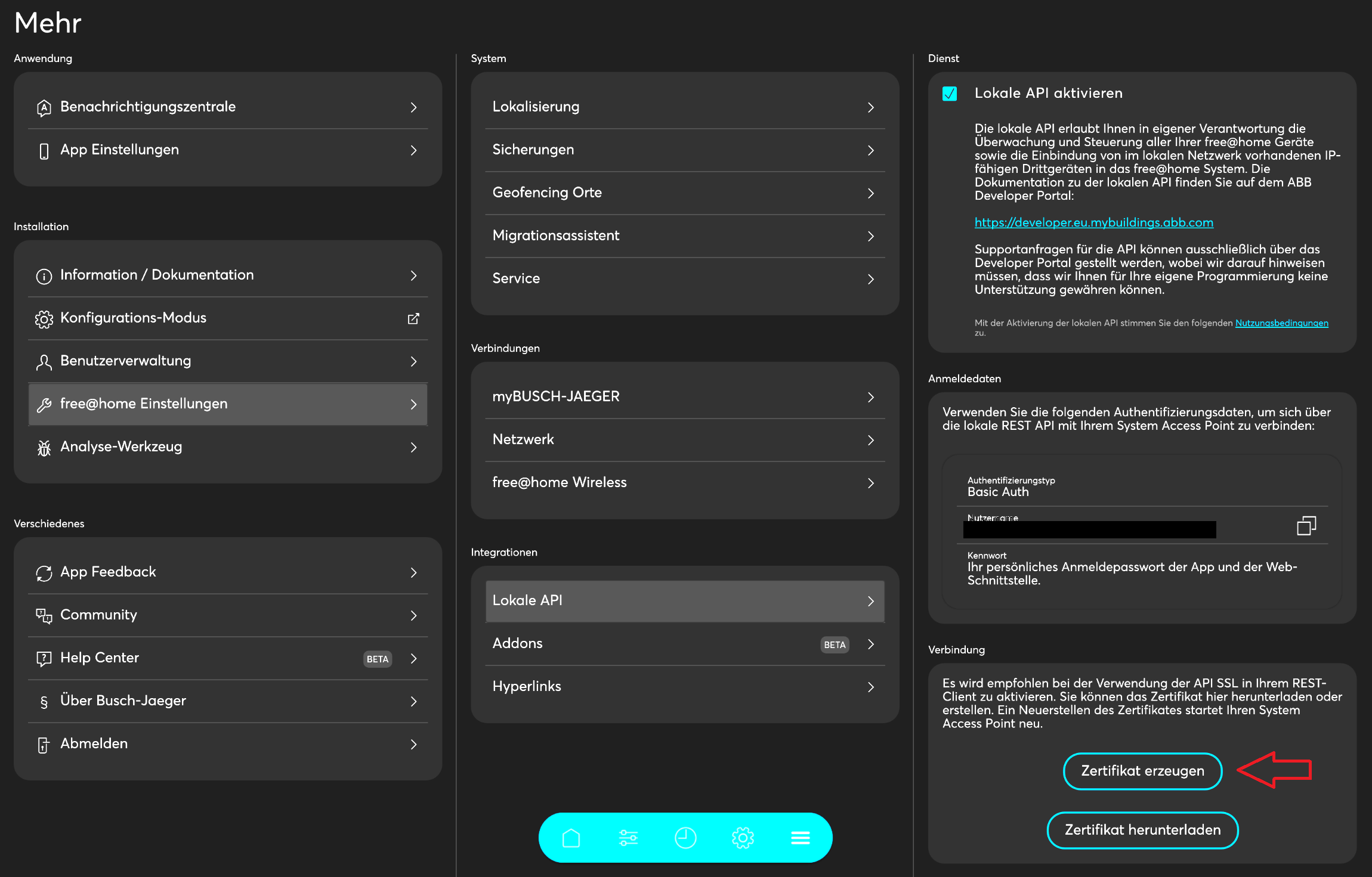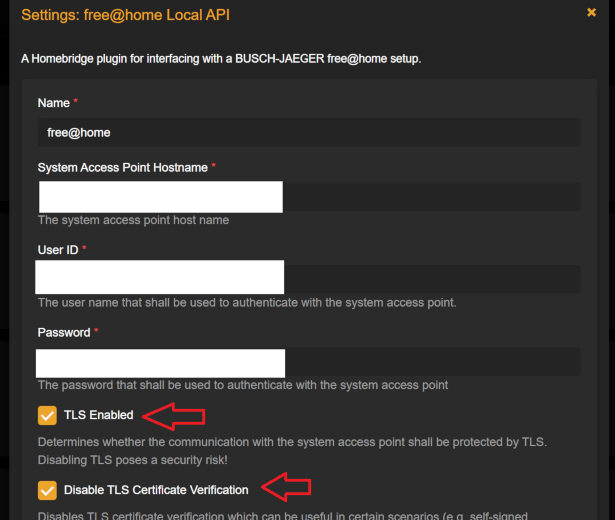homebridge-freeathome-local-api v1.14.3
homebridge-freeathome-local-api
A Homebridge plugin that allows the user to control BUSCH-JAEGER free@home devices using the System Access Point local API.
Features
- Control your BUSCH-JAEGER free@home lights, outlets, heating regulators and more with your Apple devices
- Ask Siri to control your devices and set automations with Apple Home
- Based on the local API provided by the System Access Point running firmware version >2.6.0
- 100% covered by automated unit tests
Supported accessories
I'll add further accessories over time, but feel free to request your favorite accessory type in a GitHub issue.
Official Support
The accessories listed below are well tested with automated unit tests as well as functional and stability tests on real hardware. To the best of my knowledge the accessories are behaving as they should be.
- Switch actuators: Binary switches, outlets, simple (on/off) lights
- Dimmable Lights
- Thermostats
- Door Openers
- The automatic door opener (which will be displayed as a switch)
- free@home scenes
- Smoke Detector
- Motion Sensors
- Binary door and window sensors 🏠
- Switch and dimming sensors (without the state though) 🏠
- The free@home weather station's ambient light and temperature sensors
- Wireless radiator actuators 🆕
Please note that you need to have a control center running your Apple Home to be able to use sensors. This affects all accessories indicated with the 🏠. Please check https://support.apple.com/en-us/HT207057 for additional information.
Experimental Support
Some more accessories are supported experimentally. The experimental accessories are implemented according to the BUSCH-JAEGER specification and fully unit tested, but I don't own the hardware, so I cannot perform in-situ tests for functionality, user experience and stability. If you own one or more of the devices listed below and want to help me support those accessories, please create a GitHub issue or reach out to me via email.
- Blinds Actuators
- Shutter Actuators
- Awning Actuators
- Attic Window Actuators
- Scene sensors 🏠
- Staircase light sensors 🏠
- Trigger sensors 🏠
Ignoring devices and channels
If you don't want to create an accessory for a specific channel, you can add the channel to the ignore list in the settings UI or the config.json. This is useful, if you have supported devices you don't want to expose to Apple Home or you have devices that are not usable even though they are configured. A real-world example are unused door openers provided by the Welcome Panel. A request to trigger an unused door opener will always fail with an error, so you can ignore the unused openers, to keep your Apple Home neat and avoid confusion.
The format for an ignored channel is {DeviceSerial}/{Channel}. For example: To ignore channel ch0010 of the device with the serial ABB700123456, add ABB700123456/ch0010 to the ignored channel list. To ignore all channels of a device use an asterisk for the channel part. For example, add ABB700123456/* to the ignored channel list to exclude all channels provided by the device with the serial ABB700123456.
A sample configuration section for the plugin with ignored channels might look like this:
{
"name": "My free@home Setup",
"host": "sysap.home.net",
"user": "12345678-9ACB-DEF0-1234-56789ABCDEF0",
"password": "s3cre3tP4ssw0rt",
"tlsEnabled": false,
"verboseErrors": false,
"experimental": false,
"ignoredChannels": ["ABB700123456/ch0010", "ABB700123457/*"],
"platform": "FreeAtHomeLocalApi"
}Type Mappings
Starting with plugin version v1.3.0, you can add type mappings to the config file to determine how certain devices are displayed in Apple Home. For example, a free@home binary switch actuator might be mapped to a light bulb, a regular switch or an outlet. Unfortunately, there is no way to determine the type of the connected device of a switch programmatically. So a type mapping is needed to advise the plugin to use another than the default service.
A sample configuration section for the plugin with type mappings might look like this:
{
"name": "My free@home Setup",
"host": "sysap.home.net",
"user": "12345678-9ACB-DEF0-1234-56789ABCDEF0",
"password": "s3cre3tP4ssw0rt",
"tlsEnabled": false,
"verboseErrors": false,
"experimental": false,
"typeMappings": [{ "channel": "ABB700123456/ch0001", "type": "Outlet" }],
"platform": "FreeAtHomeLocalApi"
}Please note that the type property is case-sensitive, outlet will not work!
The following type mappings are supported:
| FunctionID | Default Service | Alternative Service | Mapping Type |
|---|---|---|---|
7: FID_SWITCH_ACTUATOR | Switch | Outlet | Outlet |
Using Transport Layer Security (TLS)
The plugin supports Transport Layer Security (TLS). By enabling TLS, the connection between the Homebridge plugin and the free@home System Access Point will be encrypted making it hard to read the data that is exchanged. Before you can use TLS, you'll need to initially create a TLS certificat in your System Access Point. To do so log in to the SysAP UI, go to Settings -> free@home Settings -> Local API and click the Create Certificate Button indicated by the red arrow in the image below.

Then you can activate TLS in the Homebridge plugin by checking the corrensponding check box in the Homebridge plugin settings dialog as indicated by the upper red arrow in the image below. Please note that the TLS certificate generated by the System Access Point is a self-signed certificate. In order for the TLS handshake to complete successfully, you need to add the System Access Points TLS certificate to the trusted certificate store of the machine running Homebridge or the handshake will fail and the plugin will not start. Unfortunately, it is not possible at the moment to replace the System Access Points TLS certificate with a signed one.
You can also choose to use TLS, but disable certificate verification by checking the corresponding check box in the Homebridge plugin settings dialog as indicated by the lower red arrow in the image below. Please note that disabling TLS verification presents a possible security risk. Your connection will still be encrypted, but the authenticity of the party presenting the certificate is not verified.

Requirements
- free@home Access Point running firmware version >2.6.0
- Access to an user account that has access to the local API
Changelog
The changelog can be viewed here.
I found a bug, what do I do?
I'm happy to hear any feedback regarding the plugin or it's implementation, be it critizism, praise or rants. Please create a GitHub issue or drop me an email if you would like to contact me.
I would especially appreciate, if you could report any issues you encounter while using the library. Issues I know about, I can probably fix.
If you want to submit a bug report, please check if the issue you have has already been reported. If you want to contribute additional information to the issue, please add it to the existing issue instead of creating another one. Duplicate issues will take time from bugfixing and thus delay a fix.
While creating a bug report, please make it easy for me to fix it by giving us all the details you have about the issue. Always include the version of the library and a short concise description of the issue. Besides that, there are a few other pieces of information that help tracking down bugs:
- The system environment in which the issue occurred (e.g. node version)
- Some steps to reproduce the issue, e.g. a code snippet
- The expected behaviour and how the failed failed to meet that expectation
- Anything else you think I might need
I have a feature request, what do I do?
Please create a GitHub issue or drop me an email!
Non-Affiliation Disclaimer
This plugin is not endorsed by, directly affiliated with, maintained, authorized, or sponsored by Busch-Jaeger Elektro GmbH or ABB Asea Brown Boveri Ltd or . All product and company names are the registered trademarks of their original owners. The use of any trade name or trademark is for identification and reference purposes only and does not imply any association with the trademark holder of their product brand.
License
The project is subject to the MIT license unless otherwise noted. A copy can be found in the root directory of the project LICENSE.
Made with ❤️ by Philip Gerke
1 year ago
1 year ago
10 months ago
12 months ago
1 year ago
1 year ago
1 year ago
2 years ago
1 year ago
2 years ago
2 years ago
2 years ago
2 years ago
2 years ago
2 years ago
2 years ago
2 years ago
2 years ago
2 years ago
2 years ago
2 years ago
2 years ago
2 years ago
2 years ago
2 years ago
2 years ago
2 years ago
2 years ago
2 years ago
3 years ago
2 years ago
3 years ago
3 years ago
3 years ago
3 years ago
3 years ago
3 years ago
3 years ago
3 years ago
3 years ago
3 years ago
3 years ago
3 years ago
3 years ago
3 years ago
3 years ago
3 years ago
3 years ago
3 years ago
3 years ago
3 years ago
3 years ago
4 years ago
4 years ago
4 years ago
4 years ago
4 years ago
4 years ago
4 years ago
4 years ago



